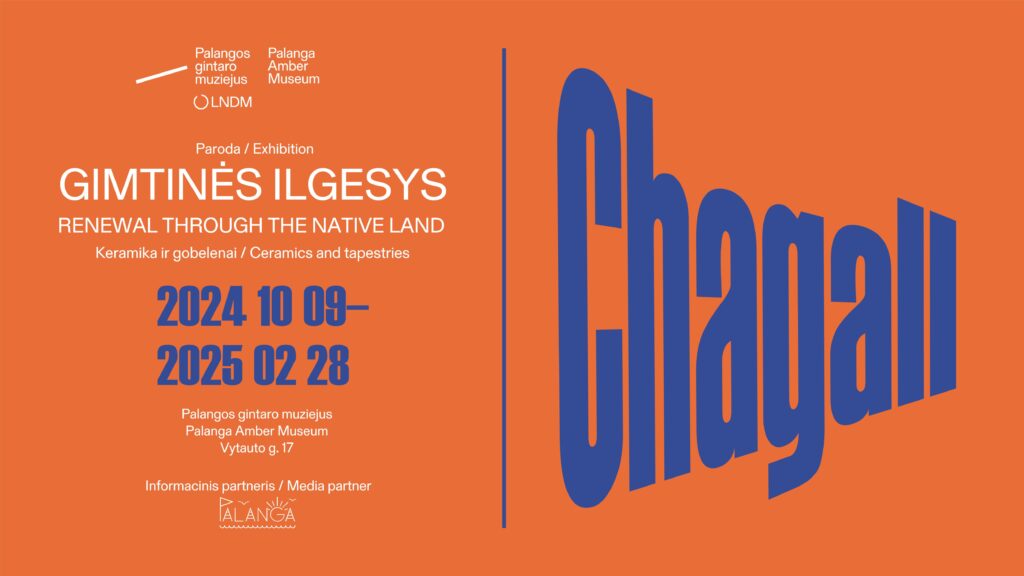Palanga Amber Museum of the LNMA presents the artwork by the world celebrated artist Marc Chagall
9 October 2024 – 28 February 2025
 Palanga Amber Museum of the LNMA invites to the opening of an exceptional exhibition Marc Chagall. Renewal Through the Native Land. Ceramics and Tapestry. It is a sequel to Chagall. Picasso. Ernst: Ceramics and Tapestry showcased by the Applied Arts and Design Museum of the LNMA in Vilnius. This immensely popular exhibition was dominated by the work of the world-famous Litvak artist Marc Chagall (1887–1985). The event in Palanga will run through 28 February 2025.
Palanga Amber Museum of the LNMA invites to the opening of an exceptional exhibition Marc Chagall. Renewal Through the Native Land. Ceramics and Tapestry. It is a sequel to Chagall. Picasso. Ernst: Ceramics and Tapestry showcased by the Applied Arts and Design Museum of the LNMA in Vilnius. This immensely popular exhibition was dominated by the work of the world-famous Litvak artist Marc Chagall (1887–1985). The event in Palanga will run through 28 February 2025.
“This time art enthusiasts get a unique opportunity to see Chagall’s lesser-known yet no less magnetic work in ceramics and textile, revealing yet another facet of his creativity. The varied selection of ceramic pieces celebrating the incredible the powers of fantasy and the refined tapestry introduce to the audience his experiments in form, texture, and narrative. Just as his legendary paintings and prints, these works invite us to enter his dream universe where folklore, mythologies and personal experience have been woven into a fantastic cloth of images and emotion,” Dr Arūnas Gelūnas, director general of the LNMA, introduces the landmark event.
A unique opportunity for coastal Lithuanians and vacationers
Over 34,000 local and visiting art devotees came to see the exhibition at the Applied Arts and Design Museum of the LNMA in Vilnius. From the 9th October, those living in coastal Lithuania and its visitors are offered the art of the legendary artist Marc Chagall on display closer to their home at The Amber Museum in Palanga. The exhibition Marc Chagall. Renewal Through the Native Land. Ceramics and Tapestry brings an inspiring artistic experience: a cultural tour of the artist’s world perception, familiarity with his authentic style, and his relationship with his past and his birth place.
The exhibition at Palanga Amber Museum of the LNMA features eighteen ceramic works, plates, jugs and vases, as well as three tapestries based on Chagall’s paintings and executed in the workshop of master weaver Yvette Cauquil-Prince.
The artist has nostalgic memories of his childhood and his native town where he grew surrounded by the Jewish traditions and Yiddish culture. According to Dr Vilma Gradinskaitė, curator of the exhibition, the themes of native land, of longing, and of marriage recur in Chagall’s art in complex multilayered images and lure the viewer to step into his world of phantasies and recollections.
“In our life there is a single color, as on an artist’s palette, which provides the meaning of our life and art. It is the color of love,” the painter Marc Chagall once said.
Primeval symbolism in Chagall’s ceramic art
Born in Vitebsk (the former Russian Empire, present-day Belarus), the artist, with his family, spent almost two decades in Paris, where he studied in different art schools. The Nazi occupation made his family leave France for the USA. He returned to France after the end of World War II and a sudden death of his beloved wife and muse Bella. Having settled in the French Riviera, where the tradition of ancient ceramics was kept alive, the artist tried his hand and discovered himself in one of the old kinds of art. From 1949 through 1972, Chagall produced over 350 ceramic works. At the Madoura pottery workshop in Vallauris he encountered the Spanish art celebrity Pablo Picasso. Both artists experimented in a variety of techniques, searching for unexpected combinations of burned glazes, making hand-built and thrown vases, plates and reliefs. According to Dr Vilma Gradinskaitė, Chagall and Picasso grasped the power of the primeval symbolism of ceramic medium, which uses fire to transform earth, e.g., clay, and imbues it with new shapes and meanings.
In the mid-1960s, Chagall met master weaver Yvette Cauquil-Prince, their creative collaboration was to last for over two decades. Cauquil-Prince applied her knowledge and skills to rendering the work by Chagall, Picasso, Max Ernst and other artists in tapestry medium. The exhibition features one of the first tapestries Creation woven based on Chagall’s cartoon (1971). After Chagall’s death in 1985 Cauquil-Prince continued weaving tapestries based on his works,” exhibition curator Dr. Vilma Gradinskaitė tells the story of the creative collaboration.
The exhibition opening at Wednesday 9 October, 5 pm at the LNMD Palanga Amber Museum will be graced by the presence of the art historian and curator Ambre Gauthier, the son of master-weaver Yvette Cauquil-Prince, artist Darius Hecqas-Cauquilas, as well as ceramics conservators Sandrine and Benoit Coignard.
Exhibition Marc Chagall. Renewal Through the Native Land. Ceramics and Tapestry
Curator: Vilma Gradinskaitė
Coordinators: Sigita Bagužaitė-Talačkienė, Regina Makauskienė
Graphic designer: Dovilė Valužytė
All artworks on display in this exhibition belong to Estate Ida Chagall / Michel Brodsky’s collection and The Estate of Yvette Cauquil-Prince.
We thank Mrs Meret Meyer, Mrs Bella Meyer and Mr Darius Hecq-Cauquil for kindly loaning the ceramic artworks and tapestries.
17 Vytauto st, LT-00101, Palanga, Lithuania
(+370 460) 30314
gintaro.muziejus@lndm.lt













